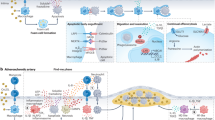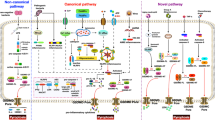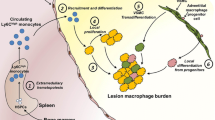Abstract
Atherosclerosis (AS) is a chronic inflammatory vascular disease that occurs in the intima of large and medium-sized arteries with the immune system’s involvement. It is a common pathological basis for high morbidity and mortality of cardiovascular diseases. Abnormal proliferation of apoptotic cells and necrotic cells leads to AS plaque expansion, necrotic core formation, and rupture. In the early stage of AS, macrophages exert an efferocytosis effect to engulf and degrade apoptotic, dead, damaged, or senescent cells by efferocytosis, thus enabling the regulation of the organism. In the early stage of AS, macrophages rely on this effect to slow down the process of AS. However, in the advanced stage of AS, the efferocytosis of macrophages within the plaque is impaired, which leads to the inability of macrophages to promptly remove the apoptotic cells (ACs) from the organism promptly, causing exacerbation of AS. Moreover, upregulation of CD47 expression in AS plaques also protects ACs from phagocytosis by macrophages, resulting in a large amount of residual ACs in the plaque, further expanding the necrotic core. In this review, we discussed the molecular mechanisms involved in the process of efferocytosis and how efferocytosis is impaired and regulated during AS, hoping to provide new insights for treating AS.


Similar content being viewed by others
Availability of data and material
Not applicable.
References
Ley K, Miller YI, Hedrick CC (2011) Monocyte and macrophage dynamics during atherogenesis. Arterioscler Thromb Vasc Biol 31(7):1506–1516
Golforoush P, Yellon DM, Davidson SM (2020) Mouse models of atherosclerosis and their suitability for the study of myocardial infarction. Basic Res Cardiol 115(6). https://doi.org/10.1007/s00395-020-00829-5
Boada-Romero E et al (2020) The clearance of dead cells by efferocytosis. Nat Rev Mol Cell Biol 21(7):398–414
Rahman MS, Woollard K (2017) Atherosclerosis. Adv Exp Med Biol 1003:121–144
Schrijvers DM et al (2005) Phagocytosis of apoptotic cells by macrophages is impaired in atherosclerosis. Arterioscler Thromb Vasc Biol 25(6):1256–1261
Penberthy KK, Lysiak JJ, Ravichandran KS (2018) RethinkingPhagocytes: Clues from the Retina and Testes. Trends Cell Biol 28(4):317–327
Evans AL et al (2017) Antagonistic coevolution of MER tyrosine kinase expression and function. Mol Biol Evol 34(7):1613–1628
Parnaik R, Raff MC, Scholes J (2000) Differences between the clearance of apoptotic cells by professional and non-professional phagocytes. Curr Biol 10(14):857–860
Arandjelovic S, Ravichandran KS (2015) Phagocytosis of apoptotic cells in homeostasis. Nat Immunol 16(9):907–917
Lu J et al (2019) Efficient engulfment of necroptotic and pyroptotic cells by nonprofessional and professional phagocytes. Cell Discov 5:39
Morioka S, Maueroder C, Ravichandran KS (2019) Living on the edge: efferocytosis at the interface of homeostasis and pathology. Immunity 50(5):1149–1162
Medina CB, Ravichandran KS (2016) Do not let death do us part: “find-me” signals in communication between dying cells and the phagocytes. Cell Death Differ 23(6):979–989
Medina CB et al (2020) Metabolites released from apoptotic cells act as tissue messengers. Nature 580(7801):130–135
Bournazou I et al (2009) Apoptotic human cells inhibit migration of granulocytes via release of lactoferrin. J Clin Invest 119(1):20–32
Lee M et al (2018) Tissue-specific role of CX(3)CR1 expressing immune cells and their relationships with human disease. Immune Netw 18(1):e5
Truman LA et al (2008) CX3CL1/fractalkine is released from apoptotic lymphocytes to stimulate macrophage chemotaxis. Blood 112(13):5026–5036
Lauber K et al (2003) Apoptotic cells induce migration of phagocytes via caspase-3-mediated release of a lipid attraction signal. Cell 113(6):717–730
Peter C et al (2012) Release of lysophospholipid “find-me” signals during apoptosis requires the ATP-binding cassette transporter A1. Autoimmunity 45(8):568–573
Apostolakis S, Spandidos D (2013) Chemokines and atherosclerosis: focus on the CX3CL1/CX3CR1 pathway. Acta Pharmacol Sin 34(10):1251–1256
Gu Y et al (2015) Defective apical extrusion signaling contributes to aggressive tumor hallmarks. Elife 4:e04069
Matsumoto T, Kobayashi T, Kamata K (2007) Role of lysophosphatidylcholine (LPC) in atherosclerosis. Curr Med Chem 14(30):3209–3220
Ferrari D et al (2015) Purinergic signaling in atherosclerosis. Trends Mol Med 21(3):184–192
Zhao X, Kruzel M, Aronowski J (2021) Lactoferrin and hematoma detoxification after intracerebral hemorrhage. Biochem Cell Biol 99(1):97–101
Chen C et al (2023) The role of lactoferrin in atherosclerosis. Biometals 36(3):509–519
da Rocha GHO et al (2019) Control of expression and activity of peroxisome proliferated-activated receptor gamma by Annexin A1 on microglia during efferocytosis. Cell Biochem Funct 37(7):560–568
Li YZ et al (2022) Annexin A protein family in atherosclerosis. Clin Chim Acta 531:406–417
Frasch SC et al (2011) Signaling via macrophage G2A enhances efferocytosis of dying neutrophils by augmentation of Rac activity. J Biol Chem 286(14):12108–12122
Cui X et al (2021) The G2A receptor deficiency aggravates atherosclerosis in rats by regulating macrophages and lipid metabolism. Front Physiol 12:659211
Barnawi J et al (2017) Reduced DNA methylation of sphingosine-1 phosphate receptor 5 in alveolar macrophages in COPD: a potential link to failed efferocytosis. Respirology 22(2):315–321
Birge RB et al (2016) Phosphatidylserine is a global immunosuppressive signal in efferocytosis, infectious disease, and cancer. Cell Death Differ 23(6):962–978
Kojima Y et al (2019) Cyclin-dependent kinase inhibitor 2B regulates efferocytosis and atherosclerosis. J Clin Invest 129(5):2164
Khatana C et al (2020) Mechanistic insights into the oxidized low-density lipoprotein-induced atherosclerosis. Oxid Med Cell Longev 2020:5245308
Tao H et al (2015) Macrophage SR-BI mediates efferocytosis via Src/PI3K/Rac1 signaling and reduces atherosclerotic lesion necrosis. J Lipid Res 56(8):1449–1460
Kojima Y et al (2016) CD47-blocking antibodies restore phagocytosis and prevent atherosclerosis. Nature 536(7614):86–90
Caligiuri G (2020) CD31 as a therapeutic target in atherosclerosis. Circ Res 126(9):1178–1189
Manta CP et al (2022) Targeting of scavenger receptors stabilin-1 and stabilin-2 ameliorates atherosclerosis by a plasma proteome switch mediating monocyte/macrophage suppression. Circulation 146(23):1783–1799
Lee W et al (2018) Macrophagic stabilin-1 restored disruption of vascular integrity caused by sepsis. Thromb Haemost 118(10):1776–1789
Foks AC et al (2016) Blockade of Tim-1 and Tim-4 enhances atherosclerosis in low-density lipoprotein receptor-deficient mice. Arterioscler Thromb Vasc Biol 36(3):456–465
Foks AC et al (2013) T-cell immunoglobulin and mucin domain 3 acts as a negative regulator of atherosclerosis. Arterioscler Thromb Vasc Biol 33(11):2558–2565
Mueller PA et al (2018) Deletion of macrophage low-density lipoprotein receptor-related protein 1 (LRP1) accelerates atherosclerosis regression and increases C-C chemokine receptor type 7 (CCR7) expression in plaque macrophages. Circulation 138(17):1850–1863
Cai B, Kasikara C (2020) TAM receptors and their ligand-mediated activation: role in atherosclerosis. Int Rev Cell Mol Biol 357:21–33
Tian K et al (2020) CD36 in atherosclerosis: pathophysiological mechanisms and therapeutic implications. Curr Atheroscler Rep 22(10):59
Hurtado B et al (2011) Expression of the vitamin K-dependent proteins GAS6 and protein S and the TAM receptor tyrosine kinases in human atherosclerotic carotid plaques. Thromb Haemost 105(5):873–882
Ait-Oufella H et al (2007) Lactadherin deficiency leads to apoptotic cell accumulation and accelerated atherosclerosis in mice. Circulation 115(16):2168–2177
Bhatia VK et al (2007) Complement C1q reduces early atherosclerosis in low-density lipoprotein receptor-deficient mice. Am J Pathol 170(1):416–426
Heo KS et al (2014) ERK5 activation in macrophages promotes efferocytosis and inhibits atherosclerosis. Circulation 130(2):180–191
McShane L et al (2019) TAM receptors in cardiovascular disease. Cardiovasc Res 115(8):1286–1295
Hanayama R et al (2002) Identification of a factor that links apoptotic cells to phagocytes. Nature 417(6885):182–187
Maiti SN et al (2008) Beta-2-glycoprotein 1-dependent macrophage uptake of apoptotic cells. Binding to lipoprotein receptor-related protein receptor family members. J Biol Chem 283(7):3761–6
Nakaya M et al (2008) Spatiotemporal activation of Rac1 for engulfment of apoptotic cells. Proc Natl Acad Sci USA 105(27):9198–9203
Barkal AA et al (2019) CD24 signalling through macrophage Siglec-10 is a target for cancer immunotherapy. Nature 572(7769):392–396
Oldenborg PA et al (2000) Role of CD47 as a marker of self on red blood cells. Science 288(5473):2051–2054
Miki H, Suetsugu S, Takenawa T (1998) WAVE, a novel WASP-family protein involved in actin reorganization induced by Rac. EMBO J 17(23):6932–6941
Yurdagul A Jr et al (2020) Macrophage metabolism of apoptotic cell-derived arginine promotes continual efferocytosis and resolution of injury. Cell Metab 31(3):518–533
Kim SY et al (2017) Coordinated balance of Rac1 and RhoA plays key roles in determining phagocytic appetite. PLoS ONE 12(4):e0174603
Yurdagul A Jr (2021) Metabolic consequences of efferocytosis and its impact on atherosclerosis. Immunometabolism 3(2). https://doi.org/10.20900/immunometab20210017
Kumar D, Pandit R, Yurdagul A Jr (2023) Mechanisms of continual efferocytosis by macrophages and its role in mitigating atherosclerosis. Immunometabolism (Cobham) 5(1):e00017
Cai B et al (2016) MerTK cleavage limits proresolving mediator biosynthesis and exacerbates tissue inflammation. Proc Natl Acad Sci USA 113(23):6526–6531
Yurdagul A Jr et al (2021) ODC (ornithine decarboxylase)-dependent putrescine synthesis maintains MerTK (MER tyrosine-protein kinase) expression to drive resolution. Arterioscler Thromb Vasc Biol 41(3):e144–e159
Thorp E et al (2011) Shedding of the Mer tyrosine kinase receptor is mediated by ADAM17 protein through a pathway involving reactive oxygen species, protein kinase Cdelta, and p38 mitogen-activated protein kinase (MAPK). J Biol Chem 286(38):33335–33344
Cai B et al (2017) MerTK receptor cleavage promotes plaque necrosis and defective resolution in atherosclerosis. J Clin Invest 127(2):564–568
Yancey PG et al (2010) Macrophage LRP-1 controls plaque cellularity by regulating efferocytosis and Akt activation. Arterioscler Thromb Vasc Biol 30(4):787–795
Yancey PG et al (2011) Low-density lipoprotein receptor-related protein 1 prevents early atherosclerosis by limiting lesional apoptosis and inflammatory Ly-6Chigh monocytosis: evidence that the effects are not apolipoprotein E dependent. Circulation 124(4):454–464
Chen J et al (2021) The dual role of low-density lipoprotein receptor-related protein 1 in atherosclerosis. Front Cardiovasc Med 8:682389
Mueller PA et al (2022) Macrophage LRP1 (low-density lipoprotein receptor-related protein 1) is required for the effect of CD47 blockade on efferocytosis and atherogenesis-brief report. Arterioscler Thromb Vasc Biol 42(1):e1–e9
Huang L et al (2019) SR-B1 drives endothelial cell LDL transcytosis via DOCK4 to promote atherosclerosis. Nature 569(7757):565–569
Yu P et al (2018) PDZK1 in leukocytes protects against cellular apoptosis and necrotic core development in atherosclerotic plaques in high fat diet fed ldl receptor deficient mice. Atherosclerosis 276:171–181
Saddar S et al (2013) Scavenger receptor class B type I is a plasma membrane cholesterol sensor. Circ Res 112(1):140–151
Tajbakhsh A et al (2018) Efferocytosis in atherosclerotic lesions: malfunctioning regulatory pathways and control mechanisms. Pharmacol Ther 188:12–25
Henson PM (2017) Cell removal: efferocytosis. Annu Rev Cell Dev Biol 33:127–144
Barclay AN, Van den Berg TK (2014) The interaction between signal regulatory protein alpha (SIRPalpha) and CD47: structure, function, and therapeutic target. Annu Rev Immunol 32:25–50
Kumar S et al (2019) Role of flow-sensitive microRNAs and long noncoding RNAs in vascular dysfunction and atherosclerosis. Vascul Pharmacol 114:76–92
Sallam T, Sandhu J, Tontonoz P (2018) Long noncoding RNA discovery in cardiovascular disease: decoding form to function. Circ Res 122(1):155–166
Ye ZM et al (2019) LncRNA MIAT sponges miR-149-5p to inhibit efferocytosis in advanced atherosclerosis through CD47 upregulation. Cell Death Dis 10(2):138
Wang P (2014) MFG-E8 and inflammation. Springer, Netherlands
Toth B et al (2009) Transglutaminase 2 is needed for the formation of an efficient phagocyte portal in macrophages engulfing apoptotic cells. J Immunol 182(4):2084–2092
Roy P, Orecchioni M, Ley K (2022) How the immune system shapes atherosclerosis: roles of innate and adaptive immunity. Nat Rev Immunol 22(4):251–265
Chang MK et al (1999) Monoclonal antibodies against oxidized low-density lipoprotein bind to apoptotic cells and inhibit their phagocytosis by elicited macrophages: evidence that oxidation-specific epitopes mediate macrophage recognition. Proc Natl Acad Sci USA 96(11):6353–6358
Polykratis A et al (2012) Conditional targeting of tumor necrosis factor receptor-associated factor 6 reveals opposing functions of Toll-like receptor signaling in endothelial and myeloid cells in a mouse model of atherosclerosis. Circulation 126(14):1739–1751
Martinez FO, Helming L, Gordon S (2009) Alternative activation of macrophages: an immunologic functional perspective. Annu Rev Immunol 27:451–483
Shapouri-Moghaddam A et al (2018) Macrophage plasticity, polarization, and function in health and disease. J Cell Physiol 233(9):6425–6440
Moore KJ, Sheedy FJ, Fisher EA (2013) Macrophages in atherosclerosis: a dynamic balance. Nat Rev Immunol 13(10):709–721
Ma X (2001) TNF-alpha and IL-12: a balancing act in macrophage functioning. Microbes Infect 3(2):121–129
Xie Y et al (2022) Novel insight on the role of macrophages in atherosclerosis: focus on polarization, apoptosis and efferocytosis. Int Immunopharmacol 113(Pt A):109260
Ji X et al (2020) Sphingosine 1-phosphate/microRNA-1249-5p/MCP-1 axis is involved in macrophage-associated inflammation in fatty liver injury in mice. Eur J Immunol 50(11):1746–1756
Doran AC et al (2017) CAMKIIgamma suppresses an efferocytosis pathway in macrophages and promotes atherosclerotic plaque necrosis. J Clin Invest 127(11):4075–4089
Brophy ML et al (2019) Myeloid-specific deletion of epsins 1 and 2 reduces atherosclerosis by preventing LRP-1 downregulation. Circ Res 124(4):e6–e19
Cui D et al (2007) Pivotal advance: macrophages become resistant to cholesterol-induced death after phagocytosis of apoptotic cells. J Leukoc Biol 82(5):1040–1050
Viaud M et al (2018) Lysosomal cholesterol hydrolysis couples efferocytosis to anti-inflammatory oxysterol production. Circ Res 122(10):1369–1384
Cai B et al (2018) MerTK signaling in macrophages promotes the synthesis of inflammation resolution mediators by suppressing CaMKII activity. Sci Signal 11(549). https://doi.org/10.20900/immunometab20210017
Morioka S et al (2018) Efferocytosis induces a novel SLC program to promote glucose uptake and lactate release. Nature 563(7733):714–718
Wei Y et al (2015) Regulation of Csf1r and Bcl6 in macrophages mediates the stage-specific effects of microRNA-155 on atherosclerosis. Arterioscler Thromb Vasc Biol 35(4):796–803
Simion V et al (2020) A macrophage-specific lncRNA regulates apoptosis and atherosclerosis by tethering HuR in the nucleus. Nat Commun 11(1):6135
Zhang Y et al (2021) Guanxinkang decoction attenuates the inflammation in atherosclerosis by regulating efferocytosis and MAPKs signaling pathway in LDLR(-/-) mice and RAW264.7 cells. Front Pharmacol 12:731769
Du X et al (2017) Isoflurane promotes phagocytosis of apoptotic neutrophils through AMPK-mediated ADAM17/Mer signaling. PLoS ONE 12(7):e0180213
Bories G et al (2013) Liver X receptor activation stimulates iron export in human alternative macrophages. Circ Res 113(11):1196–1205
Engelbertsen D et al (2019) Increased lymphocyte activation and atherosclerosis in CD47-deficient mice. Sci Rep 9(1):10608
Engelen SE et al (2022) Therapeutic strategies targeting inflammation and immunity in atherosclerosis: how to proceed? Nat Rev Cardiol 19(8):522–542
Funding
This work was supported by the Scientific Research Project of Hunan Provincial Department of Education (23A0338) and the Project of the Hunan Provincial Health Committee (D202302048902) and the College Student Innovation and Entrepreneurship Training Program of Hunan Province (S202210555279, S202310555323, S202310555104, and S202310555321), University of South China, China.
Author information
Authors and Affiliations
Contributions
Li-Xia Shu designed the review, prepared the figures, and wrote the review. Xin Guo prepared the table, consulted the literature, and co-wrote the review. Liu-li Cao revised the review. Zong-Bao Wang and Shu-Zhi Wang supervised the project, provided scientific direction, and revised the review.
Corresponding author
Ethics declarations
Ethics approval and consent to participate
Not applicable.
Competing interests
The authors declare no competing interests.
Additional information
Publisher's Note
Springer Nature remains neutral with regard to jurisdictional claims in published maps and institutional affiliations.
Rights and permissions
Springer Nature or its licensor (e.g. a society or other partner) holds exclusive rights to this article under a publishing agreement with the author(s) or other rightsholder(s); author self-archiving of the accepted manuscript version of this article is solely governed by the terms of such publishing agreement and applicable law.
About this article
Cite this article
Shu, LX., Cao, Ll., Guo, X. et al. Mechanism of efferocytosis in atherosclerosis. J Mol Med (2024). https://doi.org/10.1007/s00109-024-02439-3
Received:
Revised:
Accepted:
Published:
DOI: https://doi.org/10.1007/s00109-024-02439-3




